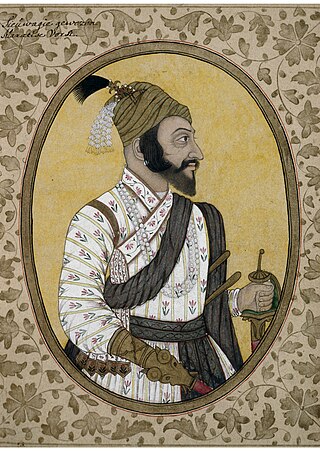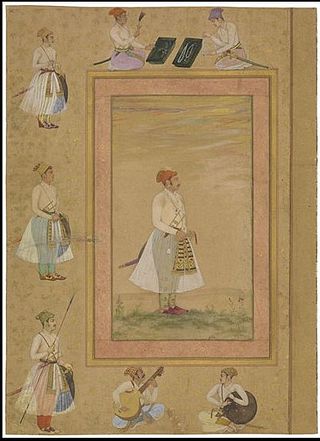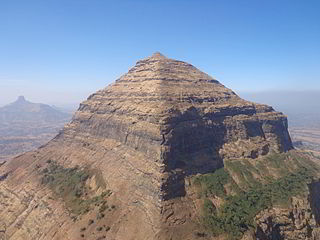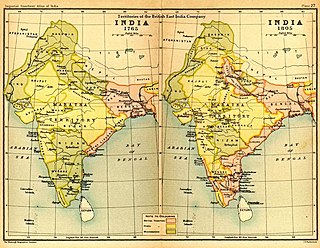
Shivaji I was an Indian ruler and a member of the Bhonsle Maratha clan. Shivaji carved out his own independent kingdom from the declining Adilshahi Sultanate of Bijapur that formed the genesis of the Maratha Empire. In 1674, he was formally crowned the Chhatrapati of his realm at Raigad Fort.

Sambhaji, also known as Shambhuraje was the second Chhatrapati of the Maratha Empire, ruling from 1681 to 1689. He was the eldest son of Shivaji, the founder of the Maratha Empire. Sambhaji's rule was largely shaped by the ongoing wars between the Maratha Empire and the Mughal Empire, as well as other neighbouring powers such as the Abyssinians of Janjira, Wadiyars of Mysore and the Portuguese Empire in Goa. After Sambhaji's execution by Aurangzeb, his brother Rajaram I succeeded him as the next Chhatrapati and continued the Mughal–Maratha Wars.

The Maratha Empire was an early modern Indian empire and later a confederation that controlled large portions of the Indian Subcontinent in the 18th century. Maratha rule formally began in 1674 with the coronation of Shivaji of the Bhonsle dynasty as the Chhatrapati. Although Shivaji came from the Maratha caste, the Maratha empire also included warriors, administrators, and other nobles from the Maratha and several other castes from what is known today as Maharashtra. The Maratha Kingdom was expanded into a full-fledged Empire in the 18th Century under the leadership of Peshwa Bajirao I.

Peshwa was second highest office in the Maratha Confederacy, next in rank and prestige only to that of the Chhatrapati. Initially serving as the appointed prime minister in the Maratha empire, the office became hereditary after the death of Shahu in 1749. During the reign of Shahu, the office of Peshwa grew in power and the Peshwas came to be the de facto rulers of the Maratha empire. However following the defeat of the Marathas in 1761, the office of the Peshwa became titular as well and from that point onwards served as the ceremonial head of the Confederacy underneath the Chhatrapati.

Chhatrapati is a royal title from Sanskrit used to denote a monarch or imperial head of state. The word "Chhatrapati" is a Sanskrit language compound word of chhatra and pati (master/lord/ruler). This title was used by the House of Bhonsle, between 1674 and 1818, as the heads of state of the Maratha Confederacy.

Shahaji Bhosale was a 17th century Indian military leader who served the Ahmadnagar Sultanate, the Bijapur Sultanate, and the Mughal Empire at various points in his career. As a member of the Bhonsle dynasty, Shahaji inherited the Pune and Supe jagirs (fiefs) from his father Maloji, who previously served the Ahmadnagar Sultanate. During the Mughal invasion of the Deccan, Shahaji joined the Mughal forces and served under Emperor Shah Jahan for a short period. After being deprived of his jagirs, he defected to the Bijapur Sultanate in 1632 and regained control over Pune and Supe. In 1638, he received the jagir of Bangalore after Bijapur's invasion of Kempe Gowda III's territories. Afterwards, he became the chief general of Bijapur and oversaw its expansion.
Moropant Trimbak Pingale (1620–1683), was the first peshwa of the Maratha Empire, serving on Shivaji Maharaj's Ashta Pradhan.

Murarbaji Deshpande was a general in the early Maratha Empire during the reign of Chatrapati Shivaji. He is best remembered for his defense of the Purandar Fort against Dilir Khan, a Mughal general who accompanied Jai Singh I in the 17th-century siege on Purandar.

Rajaram Bhonsle I was the third Chhatrapati of Maratha Empire, who ruled from 1689 to his death in 1700. He was the second son of the Shivaji, the founder of the empire and younger half-brother of Sambhaji, who he succeeded. His eleven-year reign was marked with a constant struggle against the Mughals. He was succeeded by his infant son Shivaji II under the regentship of his dowager Maharani Tarabai.

The Deccan wars were a series of military conflicts between the Mughal Empire and the descendants of the Maratha ruler Shivaji from the time of Shivaji's death in 1680 until the death of Emperor Aurangzeb in 1707. Shivaji was a central figure in what has been called "the Maratha insurgency" against the Mughal state. Both he and his son, Sambhaji, or Shambuji, typically, alternated between rebellion against the Mughal state and service to the Mughal sovereign in an official capacity. It was common practice in late 17th-century India for members of a ruling family of a small principality to both collaborate with the Mughals and rebel.

Mirza Raja Ram Singh I was the Raja of the Kingdom of Amber and head of the Kachwaha Rajput clan, succeeding his father Mirza Raja Jai Singh I. He also served as the general of the Mughal Empire and commander-in-chief of its army as well as the Subahdar of Kashmir.

Salher is a place located near Salher Village in Satana tehsil in Nashik district of Maharashtra, India.The old name of Salher was Gavalgarh. It is the site of the highest fort in the Sahyadri mountains and the second highest peak at 1,567 metres (5,141 ft) after Kalsubai in Maharashtra and 32nd highest peak in Western Ghats. This was a fort of the Maratha Empire. The money acquired after raiding Surat was brought to this fort first on its way to the Maratha capital forts.
Sangamner is a city and a municipal council located in the Ahmednagar District of Maharashtra state in India.

The Maratha Conquests were a series of conquests in the Indian subcontinent which led to the building of the Maratha Empire. These conquests were started by Shivaji in 1659, from the victory at the Battle of Pratapgad against Bijapur. The expansion of the empire was limited and interrupted by the Mughal conquests of south India by Mughal ruler Aurangzeb until he eventually died in 1707 in Deccan itself. Marathas were forced to defend their territories against the overwhelmingly strong Mughal army in the 27 years long Deccan wars. They were able to defend their territories and gain an upper hand over Mughals in the sustained conflict.

The Battle of Sinhagad, also known as Battle of Kondhana, involved an attack by the forces of the Maratha Empire during the night of 4 February 1670 on the fort of Sinhagad, near the city of Pune, Maharashtra. The Marathas captured the fort.
The Battle of Bhupalgarh occurred between the Mughal Empire and Maratha Empire in 1679. After a fierce bloody resistance to the siege lasting over 55 days, the battle resulted in the razing of the fort of Bhupalgarh and a decisive victory for the Mughals under general Diler Khan.
The Battle of Kalyan occurred between the Mughal Empire and the Maratha Empire between 1683 and 1684. Bahadur Khan of the Mughal Empire defeated the Maratha army under Tukoji and took over Kalyan. The Marathas attempted a counter-offensive but failed, and they were repulsed by Mughal forces. Sambhaji then came to fight Bahadur Khan and defeated him. Another attempt was made by Bahadur khan but was repulsed by Hambirrao Mohite

The Battle of Purandar was fought between the Mughal Empire and the Maratha Empire in 1665.
The Battle of Salher was fought between the Marathas and the Mughal Empire in February 1672 CE. The battle was fought near the fort of Salher in modern day Nashik district. The result was a decisive victory for the Marathas. This battle is considered particularly significant as it is the first pitched battle where the Mughal Empire lost to the Marathas.
Savitribai Deshmukh, better known by her title Rai Bagan or Raibagan, was a female Mughal general under the Emperor Aurangzeb. She was the widow of the Mughal sardar Raje Udaram Deshmukh of Mahur jagir in Deccan. After her son's death in Battle of Samugarh, she led her forces aiding the then prince Aurangzeb in the battle, which paved his way to become the emperor. The emperor conferred upon her the royal title. She aided Aurangzeb's uncle Shaista Khan in the Mughal campaign against the Maratha empire's founder Shivaji.














